Financial Resource Management Report: Poundland Group plc Analysis
VerifiedAdded on 2020/06/03
|11
|2754
|170
Report
AI Summary
This report provides a comprehensive analysis of financial resource management, using Poundland Group plc as a case study. It begins by differentiating between financial and management accounts, outlining their respective roles and purposes. The report then describes the function of various financial statements for both profit and non-profit organizations, including the statement of financial position, income statement, cash flow statement, and statement of changes in equity. It also examines the information needs of different stakeholder groups, categorizing them as primary, secondary, internal, and external, and detailing the types of financial reports each group requires. The core of the report involves a detailed ratio analysis of Poundland Group plc's financial statements for two consecutive years, calculating and interpreting key ratios such as gross profit margin, net profit margin, return on capital employed, inventory turnover, and various liquidity and solvency ratios. Finally, the report compares the company's financial performance and position over the two-year period based on the calculated ratios, providing insights into its financial health and performance trends.
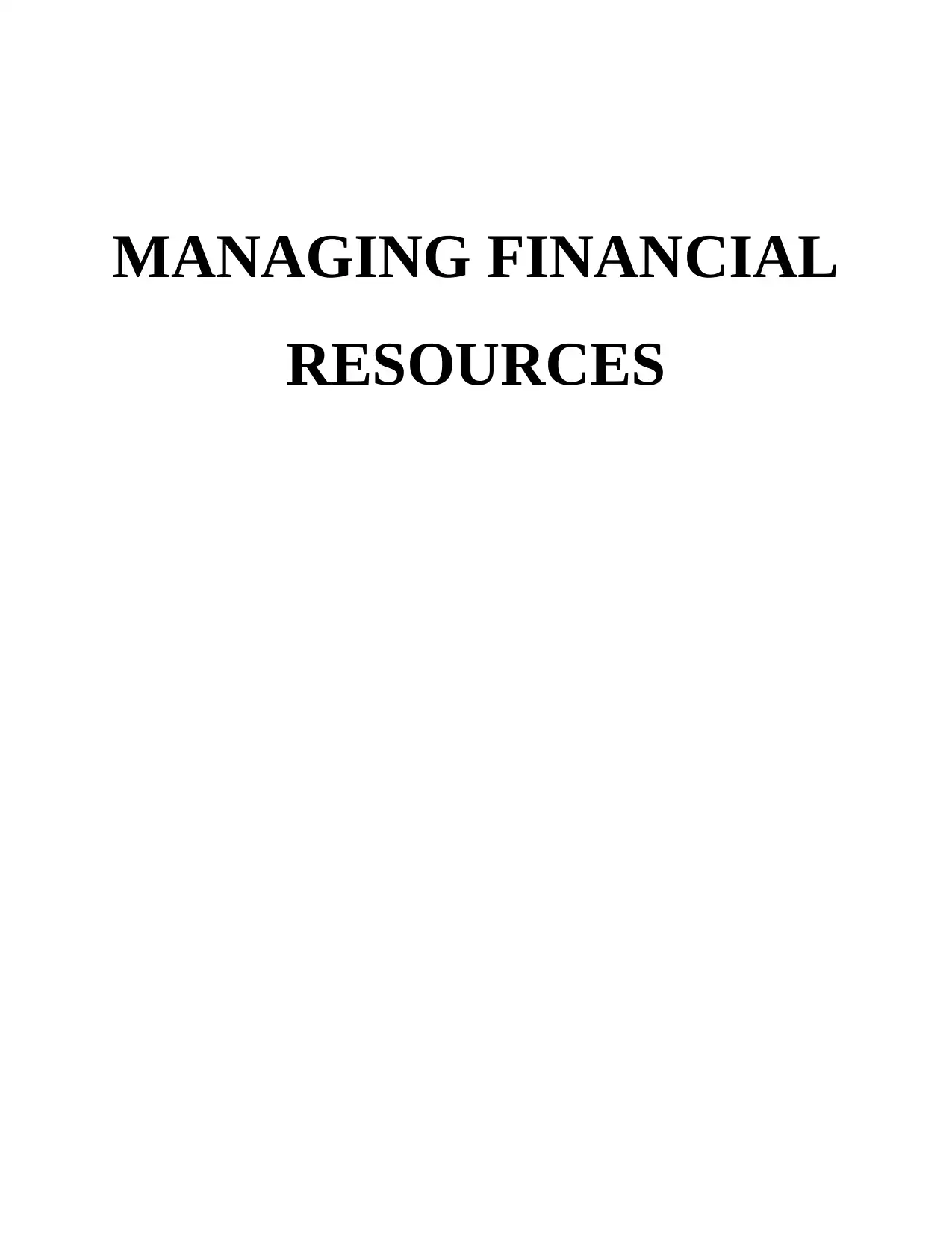
MANAGING FINANCIAL
RESOURCES
RESOURCES
Paraphrase This Document
Need a fresh take? Get an instant paraphrase of this document with our AI Paraphraser
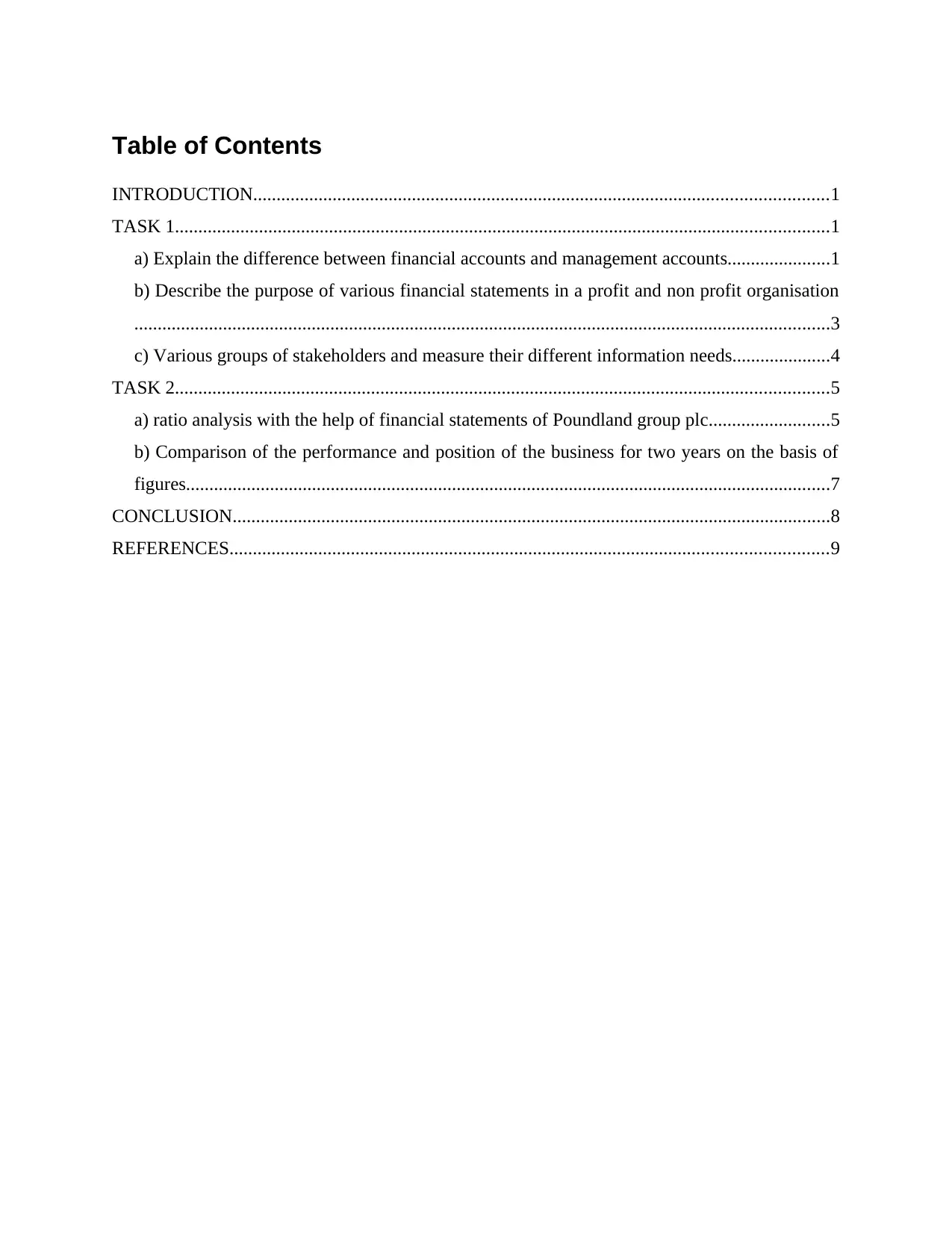
Table of Contents
INTRODUCTION...........................................................................................................................1
TASK 1............................................................................................................................................1
a) Explain the difference between financial accounts and management accounts......................1
b) Describe the purpose of various financial statements in a profit and non profit organisation
.....................................................................................................................................................3
c) Various groups of stakeholders and measure their different information needs.....................4
TASK 2............................................................................................................................................5
a) ratio analysis with the help of financial statements of Poundland group plc..........................5
b) Comparison of the performance and position of the business for two years on the basis of
figures..........................................................................................................................................7
CONCLUSION................................................................................................................................8
REFERENCES................................................................................................................................9
INTRODUCTION...........................................................................................................................1
TASK 1............................................................................................................................................1
a) Explain the difference between financial accounts and management accounts......................1
b) Describe the purpose of various financial statements in a profit and non profit organisation
.....................................................................................................................................................3
c) Various groups of stakeholders and measure their different information needs.....................4
TASK 2............................................................................................................................................5
a) ratio analysis with the help of financial statements of Poundland group plc..........................5
b) Comparison of the performance and position of the business for two years on the basis of
figures..........................................................................................................................................7
CONCLUSION................................................................................................................................8
REFERENCES................................................................................................................................9
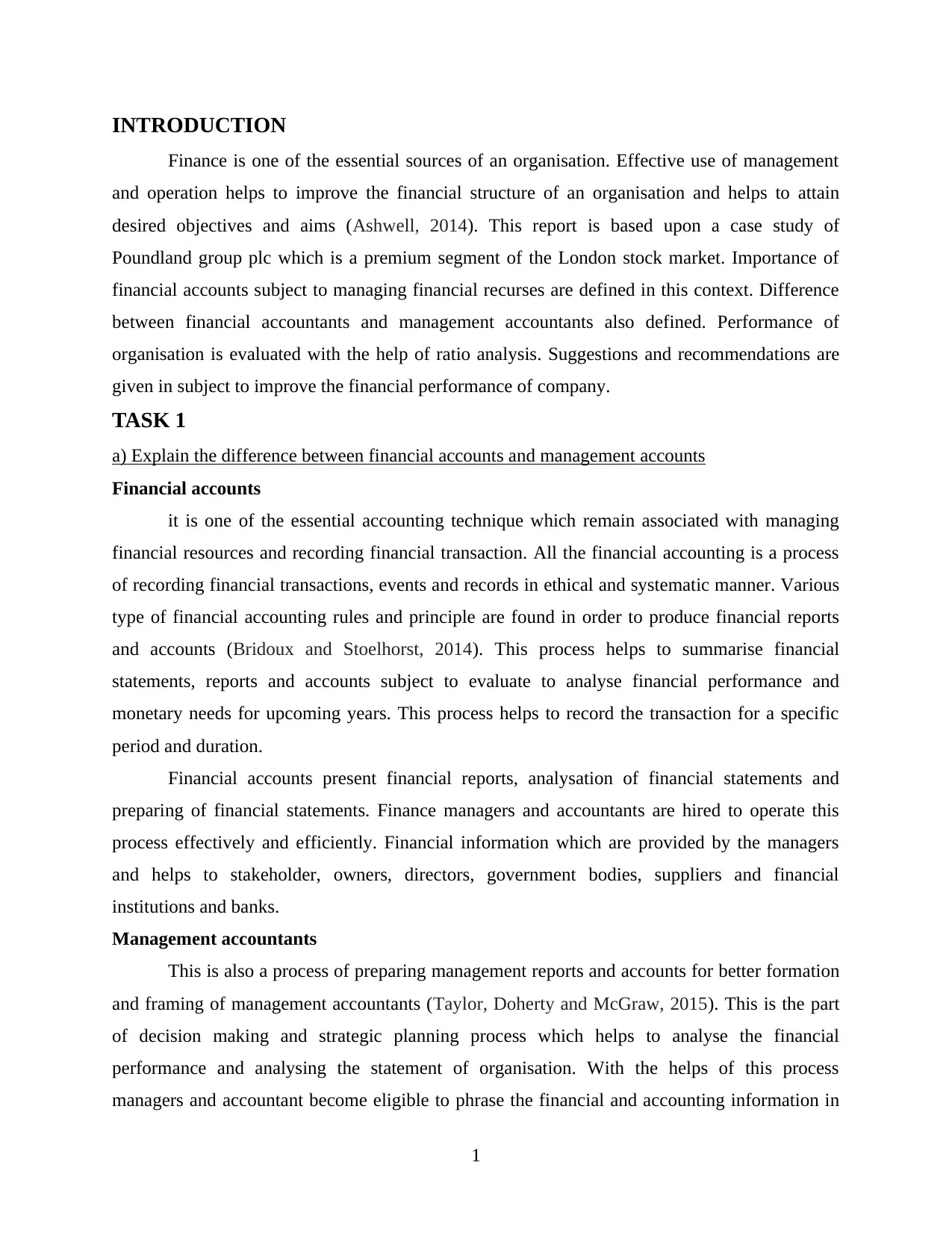
INTRODUCTION
Finance is one of the essential sources of an organisation. Effective use of management
and operation helps to improve the financial structure of an organisation and helps to attain
desired objectives and aims (Ashwell, 2014). This report is based upon a case study of
Poundland group plc which is a premium segment of the London stock market. Importance of
financial accounts subject to managing financial recurses are defined in this context. Difference
between financial accountants and management accountants also defined. Performance of
organisation is evaluated with the help of ratio analysis. Suggestions and recommendations are
given in subject to improve the financial performance of company.
TASK 1
a) Explain the difference between financial accounts and management accounts
Financial accounts
it is one of the essential accounting technique which remain associated with managing
financial resources and recording financial transaction. All the financial accounting is a process
of recording financial transactions, events and records in ethical and systematic manner. Various
type of financial accounting rules and principle are found in order to produce financial reports
and accounts (Bridoux and Stoelhorst, 2014). This process helps to summarise financial
statements, reports and accounts subject to evaluate to analyse financial performance and
monetary needs for upcoming years. This process helps to record the transaction for a specific
period and duration.
Financial accounts present financial reports, analysation of financial statements and
preparing of financial statements. Finance managers and accountants are hired to operate this
process effectively and efficiently. Financial information which are provided by the managers
and helps to stakeholder, owners, directors, government bodies, suppliers and financial
institutions and banks.
Management accountants
This is also a process of preparing management reports and accounts for better formation
and framing of management accountants (Taylor, Doherty and McGraw, 2015). This is the part
of decision making and strategic planning process which helps to analyse the financial
performance and analysing the statement of organisation. With the helps of this process
managers and accountant become eligible to phrase the financial and accounting information in
1
Finance is one of the essential sources of an organisation. Effective use of management
and operation helps to improve the financial structure of an organisation and helps to attain
desired objectives and aims (Ashwell, 2014). This report is based upon a case study of
Poundland group plc which is a premium segment of the London stock market. Importance of
financial accounts subject to managing financial recurses are defined in this context. Difference
between financial accountants and management accountants also defined. Performance of
organisation is evaluated with the help of ratio analysis. Suggestions and recommendations are
given in subject to improve the financial performance of company.
TASK 1
a) Explain the difference between financial accounts and management accounts
Financial accounts
it is one of the essential accounting technique which remain associated with managing
financial resources and recording financial transaction. All the financial accounting is a process
of recording financial transactions, events and records in ethical and systematic manner. Various
type of financial accounting rules and principle are found in order to produce financial reports
and accounts (Bridoux and Stoelhorst, 2014). This process helps to summarise financial
statements, reports and accounts subject to evaluate to analyse financial performance and
monetary needs for upcoming years. This process helps to record the transaction for a specific
period and duration.
Financial accounts present financial reports, analysation of financial statements and
preparing of financial statements. Finance managers and accountants are hired to operate this
process effectively and efficiently. Financial information which are provided by the managers
and helps to stakeholder, owners, directors, government bodies, suppliers and financial
institutions and banks.
Management accountants
This is also a process of preparing management reports and accounts for better formation
and framing of management accountants (Taylor, Doherty and McGraw, 2015). This is the part
of decision making and strategic planning process which helps to analyse the financial
performance and analysing the statement of organisation. With the helps of this process
managers and accountant become eligible to phrase the financial and accounting information in
1
⊘ This is a preview!⊘
Do you want full access?
Subscribe today to unlock all pages.

Trusted by 1+ million students worldwide
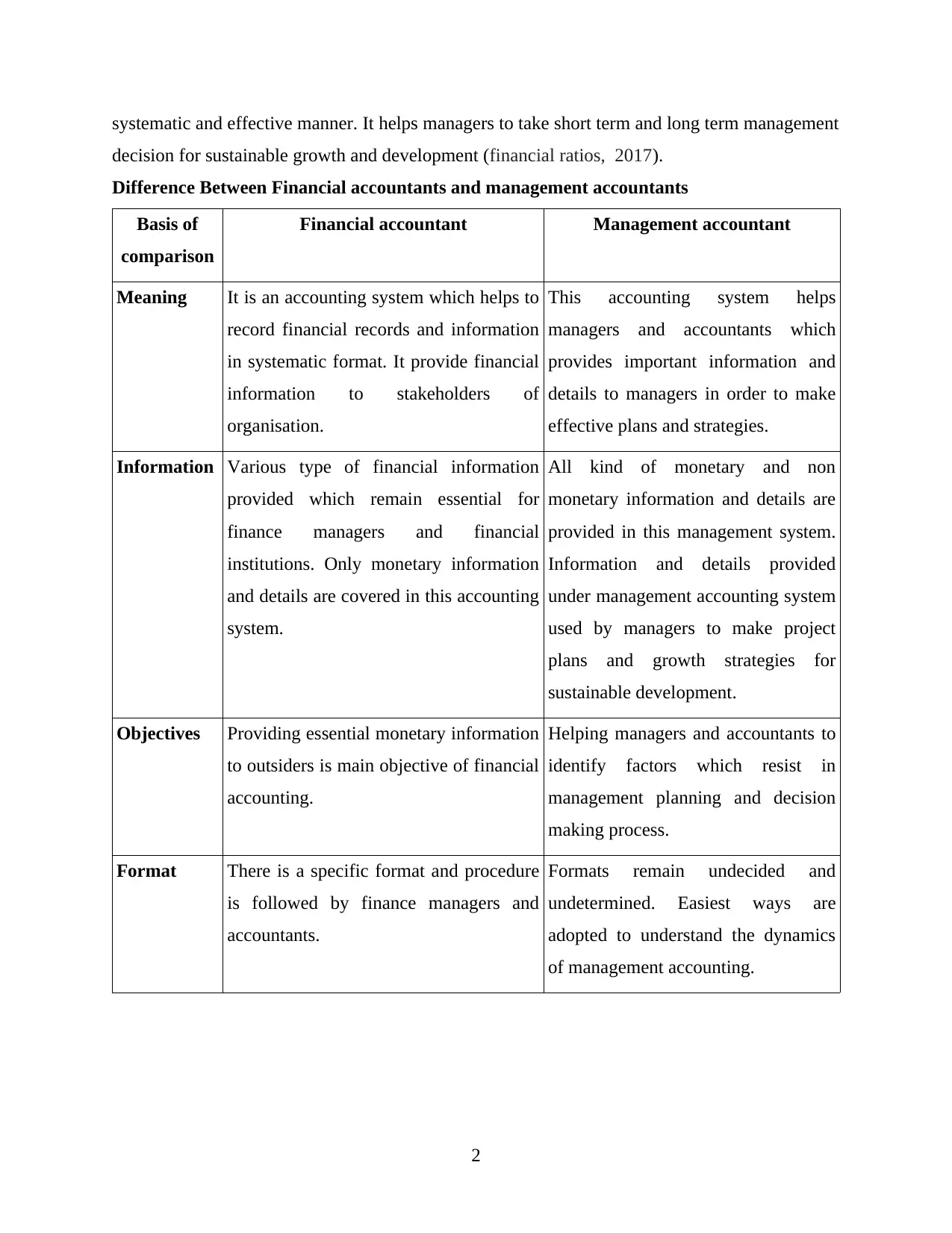
systematic and effective manner. It helps managers to take short term and long term management
decision for sustainable growth and development (financial ratios, 2017).
Difference Between Financial accountants and management accountants
Basis of
comparison
Financial accountant Management accountant
Meaning It is an accounting system which helps to
record financial records and information
in systematic format. It provide financial
information to stakeholders of
organisation.
This accounting system helps
managers and accountants which
provides important information and
details to managers in order to make
effective plans and strategies.
Information Various type of financial information
provided which remain essential for
finance managers and financial
institutions. Only monetary information
and details are covered in this accounting
system.
All kind of monetary and non
monetary information and details are
provided in this management system.
Information and details provided
under management accounting system
used by managers to make project
plans and growth strategies for
sustainable development.
Objectives Providing essential monetary information
to outsiders is main objective of financial
accounting.
Helping managers and accountants to
identify factors which resist in
management planning and decision
making process.
Format There is a specific format and procedure
is followed by finance managers and
accountants.
Formats remain undecided and
undetermined. Easiest ways are
adopted to understand the dynamics
of management accounting.
2
decision for sustainable growth and development (financial ratios, 2017).
Difference Between Financial accountants and management accountants
Basis of
comparison
Financial accountant Management accountant
Meaning It is an accounting system which helps to
record financial records and information
in systematic format. It provide financial
information to stakeholders of
organisation.
This accounting system helps
managers and accountants which
provides important information and
details to managers in order to make
effective plans and strategies.
Information Various type of financial information
provided which remain essential for
finance managers and financial
institutions. Only monetary information
and details are covered in this accounting
system.
All kind of monetary and non
monetary information and details are
provided in this management system.
Information and details provided
under management accounting system
used by managers to make project
plans and growth strategies for
sustainable development.
Objectives Providing essential monetary information
to outsiders is main objective of financial
accounting.
Helping managers and accountants to
identify factors which resist in
management planning and decision
making process.
Format There is a specific format and procedure
is followed by finance managers and
accountants.
Formats remain undecided and
undetermined. Easiest ways are
adopted to understand the dynamics
of management accounting.
2
Paraphrase This Document
Need a fresh take? Get an instant paraphrase of this document with our AI Paraphraser
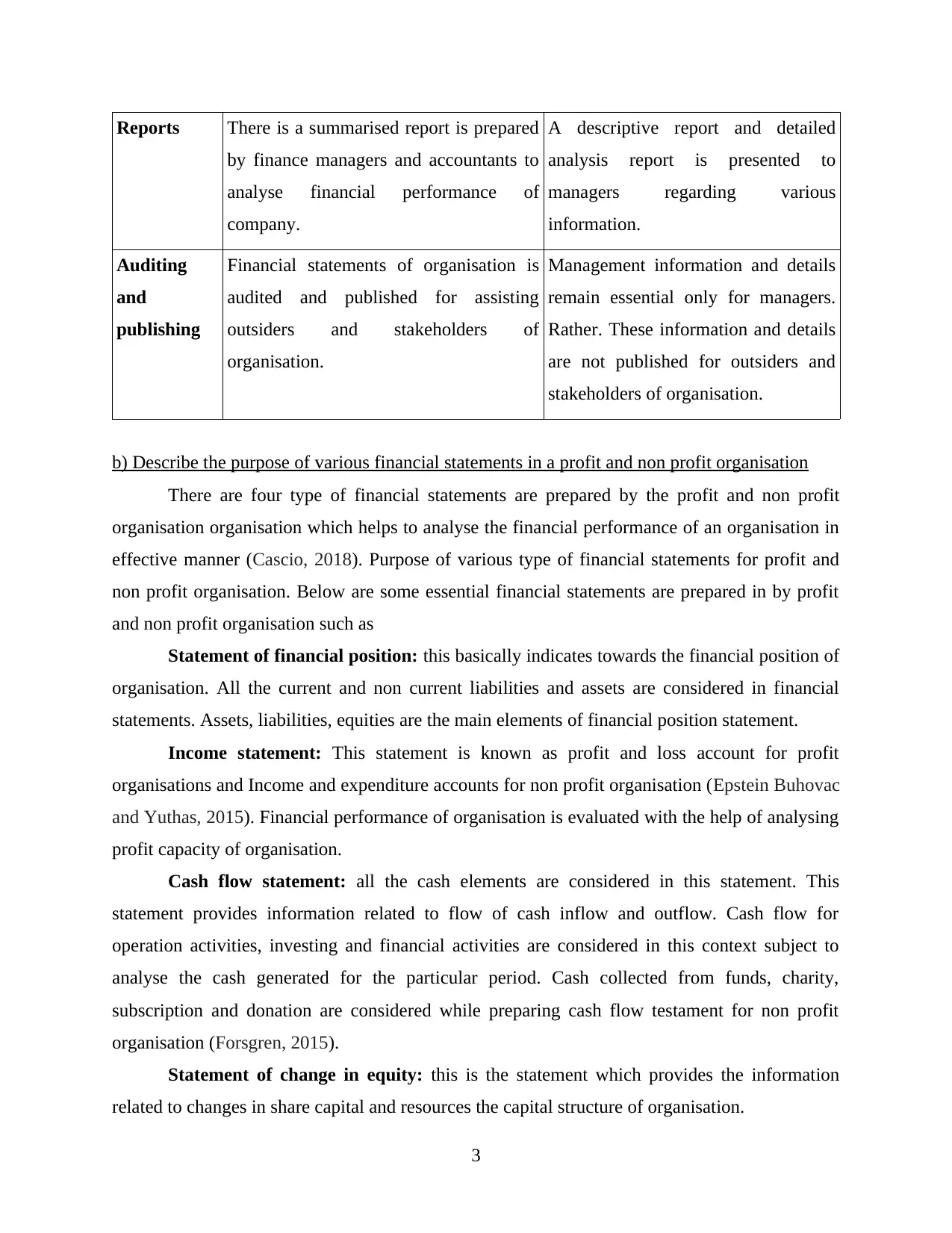
Reports There is a summarised report is prepared
by finance managers and accountants to
analyse financial performance of
company.
A descriptive report and detailed
analysis report is presented to
managers regarding various
information.
Auditing
and
publishing
Financial statements of organisation is
audited and published for assisting
outsiders and stakeholders of
organisation.
Management information and details
remain essential only for managers.
Rather. These information and details
are not published for outsiders and
stakeholders of organisation.
b) Describe the purpose of various financial statements in a profit and non profit organisation
There are four type of financial statements are prepared by the profit and non profit
organisation organisation which helps to analyse the financial performance of an organisation in
effective manner (Cascio, 2018). Purpose of various type of financial statements for profit and
non profit organisation. Below are some essential financial statements are prepared in by profit
and non profit organisation such as
Statement of financial position: this basically indicates towards the financial position of
organisation. All the current and non current liabilities and assets are considered in financial
statements. Assets, liabilities, equities are the main elements of financial position statement.
Income statement: This statement is known as profit and loss account for profit
organisations and Income and expenditure accounts for non profit organisation (Epstein Buhovac
and Yuthas, 2015). Financial performance of organisation is evaluated with the help of analysing
profit capacity of organisation.
Cash flow statement: all the cash elements are considered in this statement. This
statement provides information related to flow of cash inflow and outflow. Cash flow for
operation activities, investing and financial activities are considered in this context subject to
analyse the cash generated for the particular period. Cash collected from funds, charity,
subscription and donation are considered while preparing cash flow testament for non profit
organisation (Forsgren, 2015).
Statement of change in equity: this is the statement which provides the information
related to changes in share capital and resources the capital structure of organisation.
3
by finance managers and accountants to
analyse financial performance of
company.
A descriptive report and detailed
analysis report is presented to
managers regarding various
information.
Auditing
and
publishing
Financial statements of organisation is
audited and published for assisting
outsiders and stakeholders of
organisation.
Management information and details
remain essential only for managers.
Rather. These information and details
are not published for outsiders and
stakeholders of organisation.
b) Describe the purpose of various financial statements in a profit and non profit organisation
There are four type of financial statements are prepared by the profit and non profit
organisation organisation which helps to analyse the financial performance of an organisation in
effective manner (Cascio, 2018). Purpose of various type of financial statements for profit and
non profit organisation. Below are some essential financial statements are prepared in by profit
and non profit organisation such as
Statement of financial position: this basically indicates towards the financial position of
organisation. All the current and non current liabilities and assets are considered in financial
statements. Assets, liabilities, equities are the main elements of financial position statement.
Income statement: This statement is known as profit and loss account for profit
organisations and Income and expenditure accounts for non profit organisation (Epstein Buhovac
and Yuthas, 2015). Financial performance of organisation is evaluated with the help of analysing
profit capacity of organisation.
Cash flow statement: all the cash elements are considered in this statement. This
statement provides information related to flow of cash inflow and outflow. Cash flow for
operation activities, investing and financial activities are considered in this context subject to
analyse the cash generated for the particular period. Cash collected from funds, charity,
subscription and donation are considered while preparing cash flow testament for non profit
organisation (Forsgren, 2015).
Statement of change in equity: this is the statement which provides the information
related to changes in share capital and resources the capital structure of organisation.
3
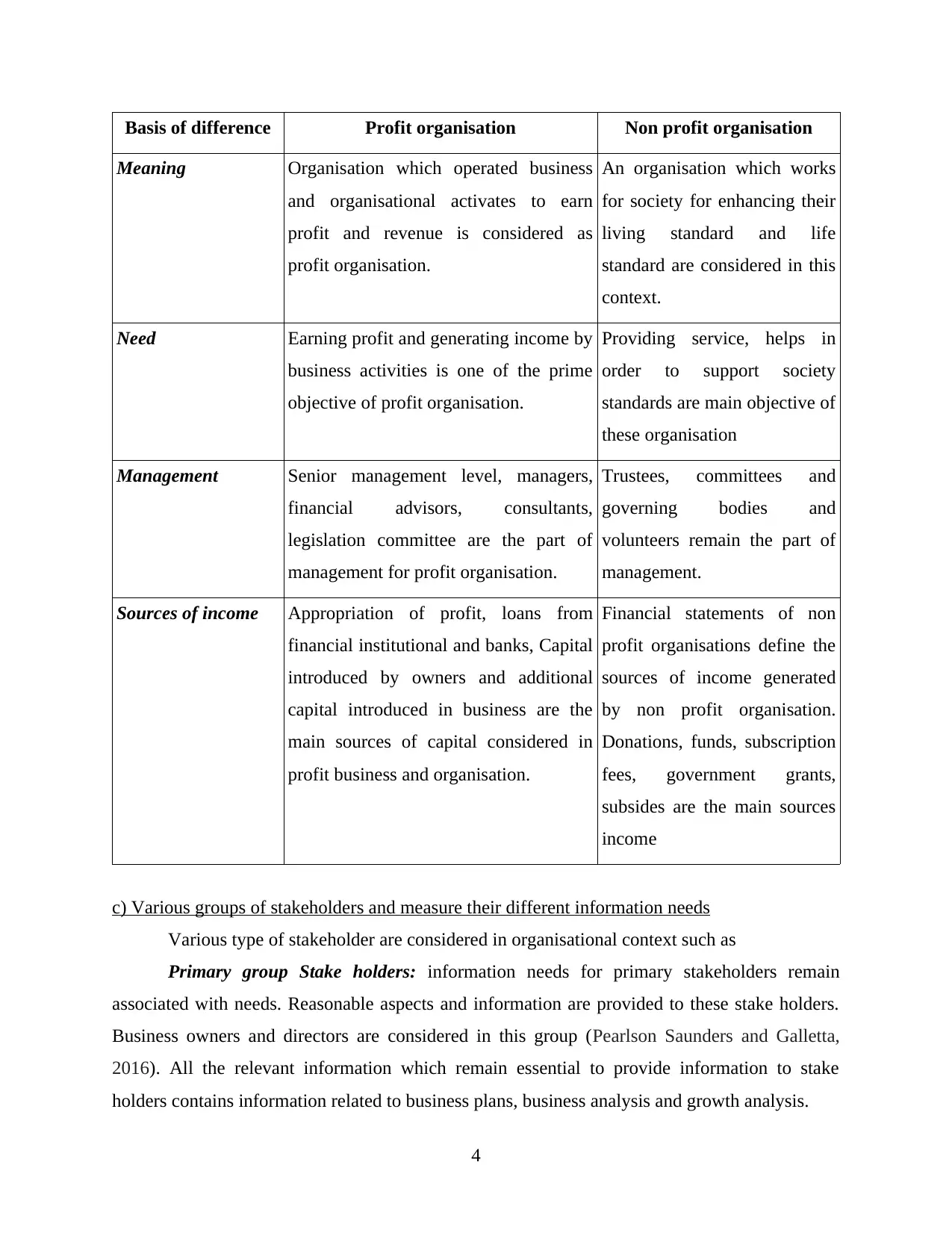
Basis of difference Profit organisation Non profit organisation
Meaning Organisation which operated business
and organisational activates to earn
profit and revenue is considered as
profit organisation.
An organisation which works
for society for enhancing their
living standard and life
standard are considered in this
context.
Need Earning profit and generating income by
business activities is one of the prime
objective of profit organisation.
Providing service, helps in
order to support society
standards are main objective of
these organisation
Management Senior management level, managers,
financial advisors, consultants,
legislation committee are the part of
management for profit organisation.
Trustees, committees and
governing bodies and
volunteers remain the part of
management.
Sources of income Appropriation of profit, loans from
financial institutional and banks, Capital
introduced by owners and additional
capital introduced in business are the
main sources of capital considered in
profit business and organisation.
Financial statements of non
profit organisations define the
sources of income generated
by non profit organisation.
Donations, funds, subscription
fees, government grants,
subsides are the main sources
income
c) Various groups of stakeholders and measure their different information needs
Various type of stakeholder are considered in organisational context such as
Primary group Stake holders: information needs for primary stakeholders remain
associated with needs. Reasonable aspects and information are provided to these stake holders.
Business owners and directors are considered in this group (Pearlson Saunders and Galletta,
2016). All the relevant information which remain essential to provide information to stake
holders contains information related to business plans, business analysis and growth analysis.
4
Meaning Organisation which operated business
and organisational activates to earn
profit and revenue is considered as
profit organisation.
An organisation which works
for society for enhancing their
living standard and life
standard are considered in this
context.
Need Earning profit and generating income by
business activities is one of the prime
objective of profit organisation.
Providing service, helps in
order to support society
standards are main objective of
these organisation
Management Senior management level, managers,
financial advisors, consultants,
legislation committee are the part of
management for profit organisation.
Trustees, committees and
governing bodies and
volunteers remain the part of
management.
Sources of income Appropriation of profit, loans from
financial institutional and banks, Capital
introduced by owners and additional
capital introduced in business are the
main sources of capital considered in
profit business and organisation.
Financial statements of non
profit organisations define the
sources of income generated
by non profit organisation.
Donations, funds, subscription
fees, government grants,
subsides are the main sources
income
c) Various groups of stakeholders and measure their different information needs
Various type of stakeholder are considered in organisational context such as
Primary group Stake holders: information needs for primary stakeholders remain
associated with needs. Reasonable aspects and information are provided to these stake holders.
Business owners and directors are considered in this group (Pearlson Saunders and Galletta,
2016). All the relevant information which remain essential to provide information to stake
holders contains information related to business plans, business analysis and growth analysis.
4
⊘ This is a preview!⊘
Do you want full access?
Subscribe today to unlock all pages.

Trusted by 1+ million students worldwide
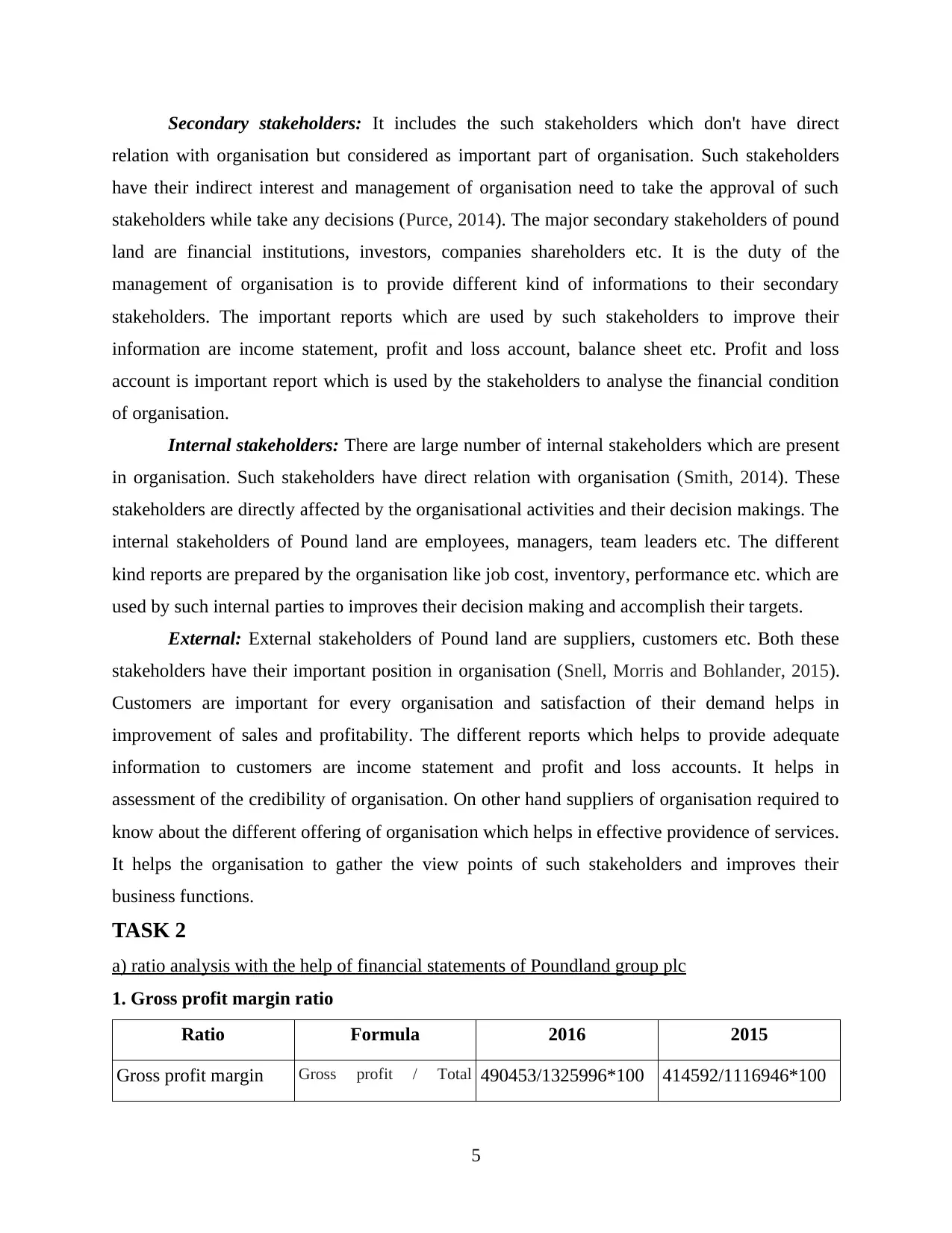
Secondary stakeholders: It includes the such stakeholders which don't have direct
relation with organisation but considered as important part of organisation. Such stakeholders
have their indirect interest and management of organisation need to take the approval of such
stakeholders while take any decisions (Purce, 2014). The major secondary stakeholders of pound
land are financial institutions, investors, companies shareholders etc. It is the duty of the
management of organisation is to provide different kind of informations to their secondary
stakeholders. The important reports which are used by such stakeholders to improve their
information are income statement, profit and loss account, balance sheet etc. Profit and loss
account is important report which is used by the stakeholders to analyse the financial condition
of organisation.
Internal stakeholders: There are large number of internal stakeholders which are present
in organisation. Such stakeholders have direct relation with organisation (Smith, 2014). These
stakeholders are directly affected by the organisational activities and their decision makings. The
internal stakeholders of Pound land are employees, managers, team leaders etc. The different
kind reports are prepared by the organisation like job cost, inventory, performance etc. which are
used by such internal parties to improves their decision making and accomplish their targets.
External: External stakeholders of Pound land are suppliers, customers etc. Both these
stakeholders have their important position in organisation (Snell, Morris and Bohlander, 2015).
Customers are important for every organisation and satisfaction of their demand helps in
improvement of sales and profitability. The different reports which helps to provide adequate
information to customers are income statement and profit and loss accounts. It helps in
assessment of the credibility of organisation. On other hand suppliers of organisation required to
know about the different offering of organisation which helps in effective providence of services.
It helps the organisation to gather the view points of such stakeholders and improves their
business functions.
TASK 2
a) ratio analysis with the help of financial statements of Poundland group plc
1. Gross profit margin ratio
Ratio Formula 2016 2015
Gross profit margin Gross profit / Total 490453/1325996*100 414592/1116946*100
5
relation with organisation but considered as important part of organisation. Such stakeholders
have their indirect interest and management of organisation need to take the approval of such
stakeholders while take any decisions (Purce, 2014). The major secondary stakeholders of pound
land are financial institutions, investors, companies shareholders etc. It is the duty of the
management of organisation is to provide different kind of informations to their secondary
stakeholders. The important reports which are used by such stakeholders to improve their
information are income statement, profit and loss account, balance sheet etc. Profit and loss
account is important report which is used by the stakeholders to analyse the financial condition
of organisation.
Internal stakeholders: There are large number of internal stakeholders which are present
in organisation. Such stakeholders have direct relation with organisation (Smith, 2014). These
stakeholders are directly affected by the organisational activities and their decision makings. The
internal stakeholders of Pound land are employees, managers, team leaders etc. The different
kind reports are prepared by the organisation like job cost, inventory, performance etc. which are
used by such internal parties to improves their decision making and accomplish their targets.
External: External stakeholders of Pound land are suppliers, customers etc. Both these
stakeholders have their important position in organisation (Snell, Morris and Bohlander, 2015).
Customers are important for every organisation and satisfaction of their demand helps in
improvement of sales and profitability. The different reports which helps to provide adequate
information to customers are income statement and profit and loss accounts. It helps in
assessment of the credibility of organisation. On other hand suppliers of organisation required to
know about the different offering of organisation which helps in effective providence of services.
It helps the organisation to gather the view points of such stakeholders and improves their
business functions.
TASK 2
a) ratio analysis with the help of financial statements of Poundland group plc
1. Gross profit margin ratio
Ratio Formula 2016 2015
Gross profit margin Gross profit / Total 490453/1325996*100 414592/1116946*100
5
Paraphrase This Document
Need a fresh take? Get an instant paraphrase of this document with our AI Paraphraser
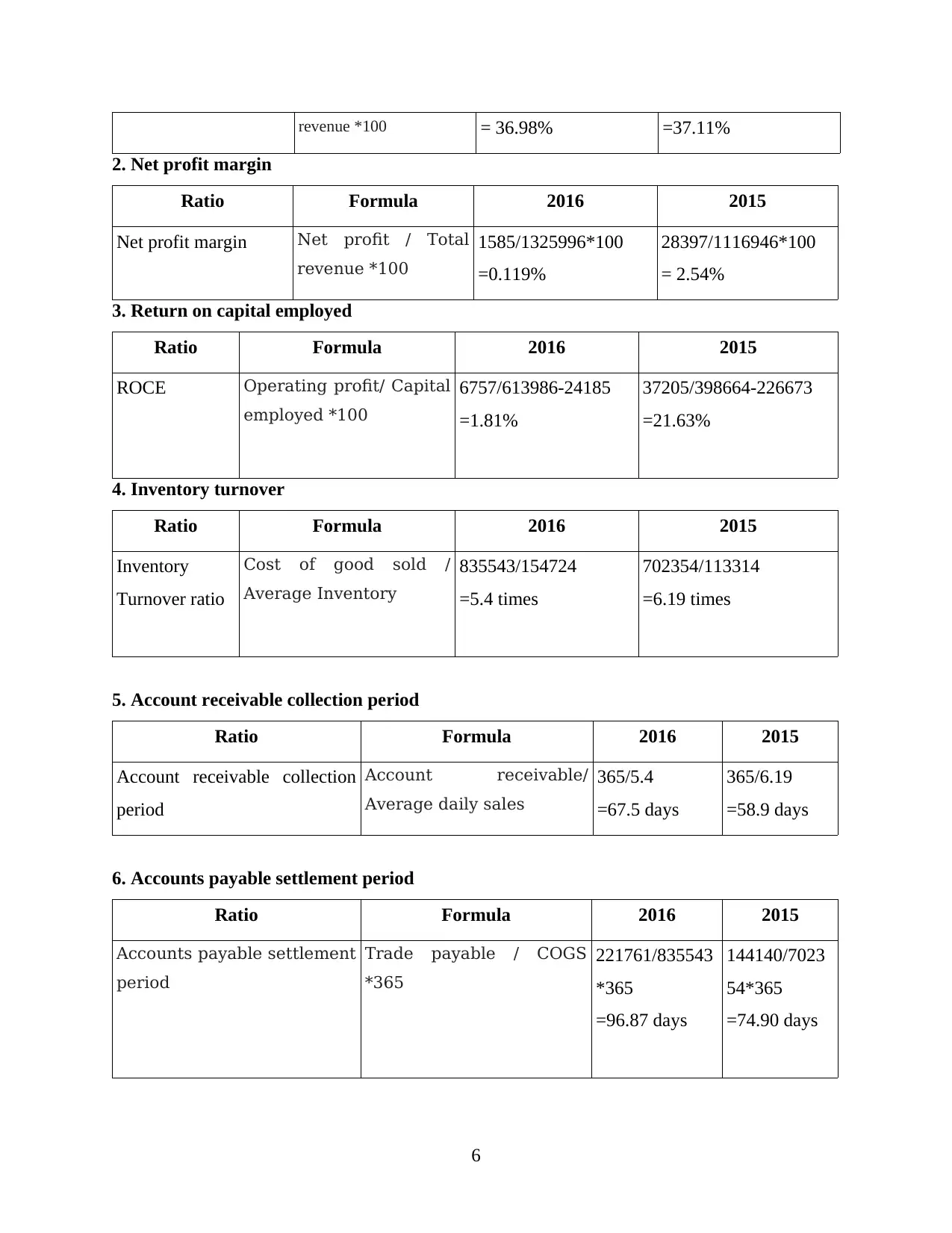
revenue *100 = 36.98% =37.11%
2. Net profit margin
Ratio Formula 2016 2015
Net profit margin Net profit / Total
revenue *100
1585/1325996*100
=0.119%
28397/1116946*100
= 2.54%
3. Return on capital employed
Ratio Formula 2016 2015
ROCE Operating profit/ Capital
employed *100
6757/613986-24185
=1.81%
37205/398664-226673
=21.63%
4. Inventory turnover
Ratio Formula 2016 2015
Inventory
Turnover ratio
Cost of good sold /
Average Inventory
835543/154724
=5.4 times
702354/113314
=6.19 times
5. Account receivable collection period
Ratio Formula 2016 2015
Account receivable collection
period
Account receivable/
Average daily sales
365/5.4
=67.5 days
365/6.19
=58.9 days
6. Accounts payable settlement period
Ratio Formula 2016 2015
Accounts payable settlement
period
Trade payable / COGS
*365
221761/835543
*365
=96.87 days
144140/7023
54*365
=74.90 days
6
2. Net profit margin
Ratio Formula 2016 2015
Net profit margin Net profit / Total
revenue *100
1585/1325996*100
=0.119%
28397/1116946*100
= 2.54%
3. Return on capital employed
Ratio Formula 2016 2015
ROCE Operating profit/ Capital
employed *100
6757/613986-24185
=1.81%
37205/398664-226673
=21.63%
4. Inventory turnover
Ratio Formula 2016 2015
Inventory
Turnover ratio
Cost of good sold /
Average Inventory
835543/154724
=5.4 times
702354/113314
=6.19 times
5. Account receivable collection period
Ratio Formula 2016 2015
Account receivable collection
period
Account receivable/
Average daily sales
365/5.4
=67.5 days
365/6.19
=58.9 days
6. Accounts payable settlement period
Ratio Formula 2016 2015
Accounts payable settlement
period
Trade payable / COGS
*365
221761/835543
*365
=96.87 days
144140/7023
54*365
=74.90 days
6
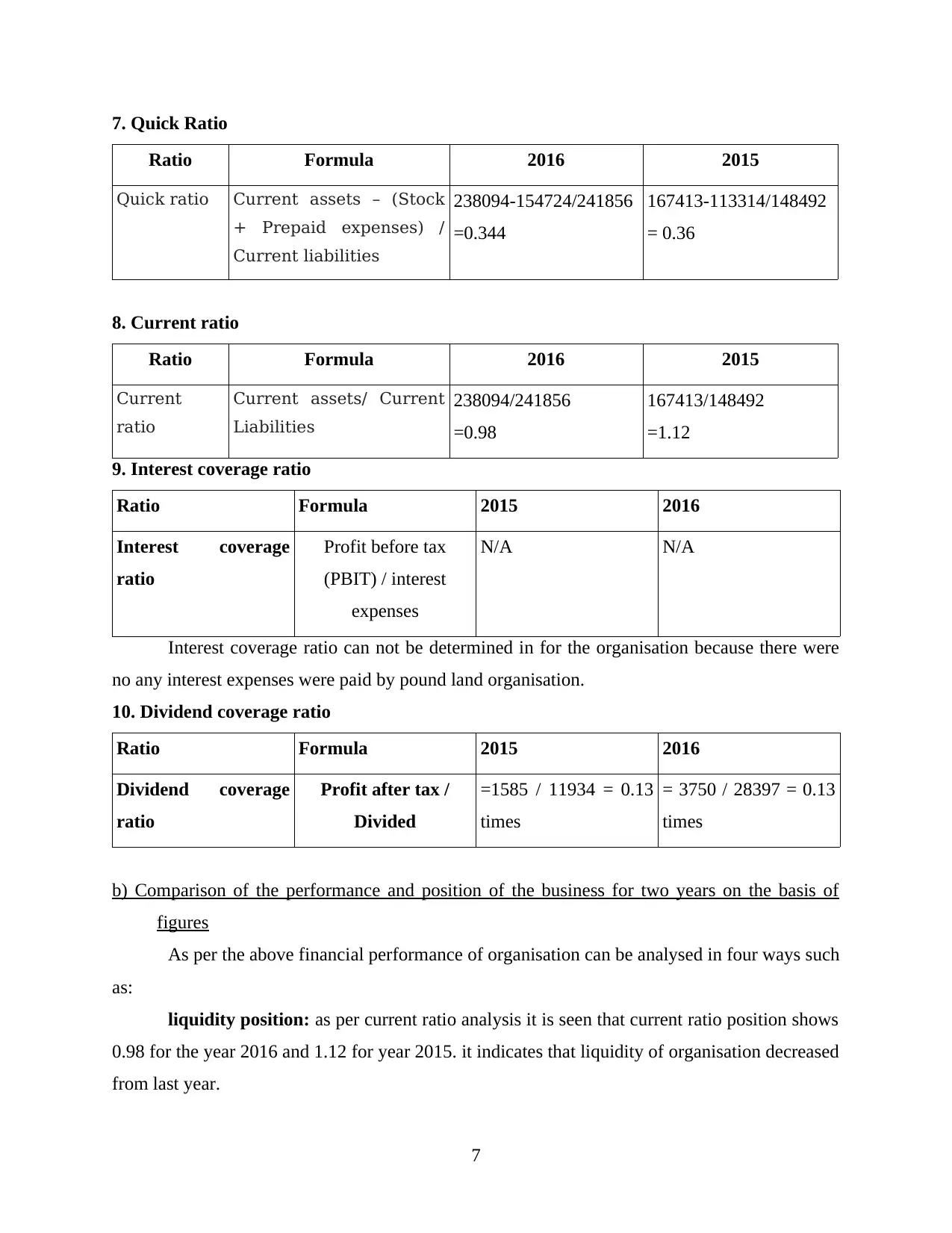
7. Quick Ratio
Ratio Formula 2016 2015
Quick ratio Current assets – (Stock
+ Prepaid expenses) /
Current liabilities
238094-154724/241856
=0.344
167413-113314/148492
= 0.36
8. Current ratio
Ratio Formula 2016 2015
Current
ratio
Current assets/ Current
Liabilities
238094/241856
=0.98
167413/148492
=1.12
9. Interest coverage ratio
Ratio Formula 2015 2016
Interest coverage
ratio
Profit before tax
(PBIT) / interest
expenses
N/A N/A
Interest coverage ratio can not be determined in for the organisation because there were
no any interest expenses were paid by pound land organisation.
10. Dividend coverage ratio
Ratio Formula 2015 2016
Dividend coverage
ratio
Profit after tax /
Divided
=1585 / 11934 = 0.13
times
= 3750 / 28397 = 0.13
times
b) Comparison of the performance and position of the business for two years on the basis of
figures
As per the above financial performance of organisation can be analysed in four ways such
as:
liquidity position: as per current ratio analysis it is seen that current ratio position shows
0.98 for the year 2016 and 1.12 for year 2015. it indicates that liquidity of organisation decreased
from last year.
7
Ratio Formula 2016 2015
Quick ratio Current assets – (Stock
+ Prepaid expenses) /
Current liabilities
238094-154724/241856
=0.344
167413-113314/148492
= 0.36
8. Current ratio
Ratio Formula 2016 2015
Current
ratio
Current assets/ Current
Liabilities
238094/241856
=0.98
167413/148492
=1.12
9. Interest coverage ratio
Ratio Formula 2015 2016
Interest coverage
ratio
Profit before tax
(PBIT) / interest
expenses
N/A N/A
Interest coverage ratio can not be determined in for the organisation because there were
no any interest expenses were paid by pound land organisation.
10. Dividend coverage ratio
Ratio Formula 2015 2016
Dividend coverage
ratio
Profit after tax /
Divided
=1585 / 11934 = 0.13
times
= 3750 / 28397 = 0.13
times
b) Comparison of the performance and position of the business for two years on the basis of
figures
As per the above financial performance of organisation can be analysed in four ways such
as:
liquidity position: as per current ratio analysis it is seen that current ratio position shows
0.98 for the year 2016 and 1.12 for year 2015. it indicates that liquidity of organisation decreased
from last year.
7
⊘ This is a preview!⊘
Do you want full access?
Subscribe today to unlock all pages.

Trusted by 1+ million students worldwide
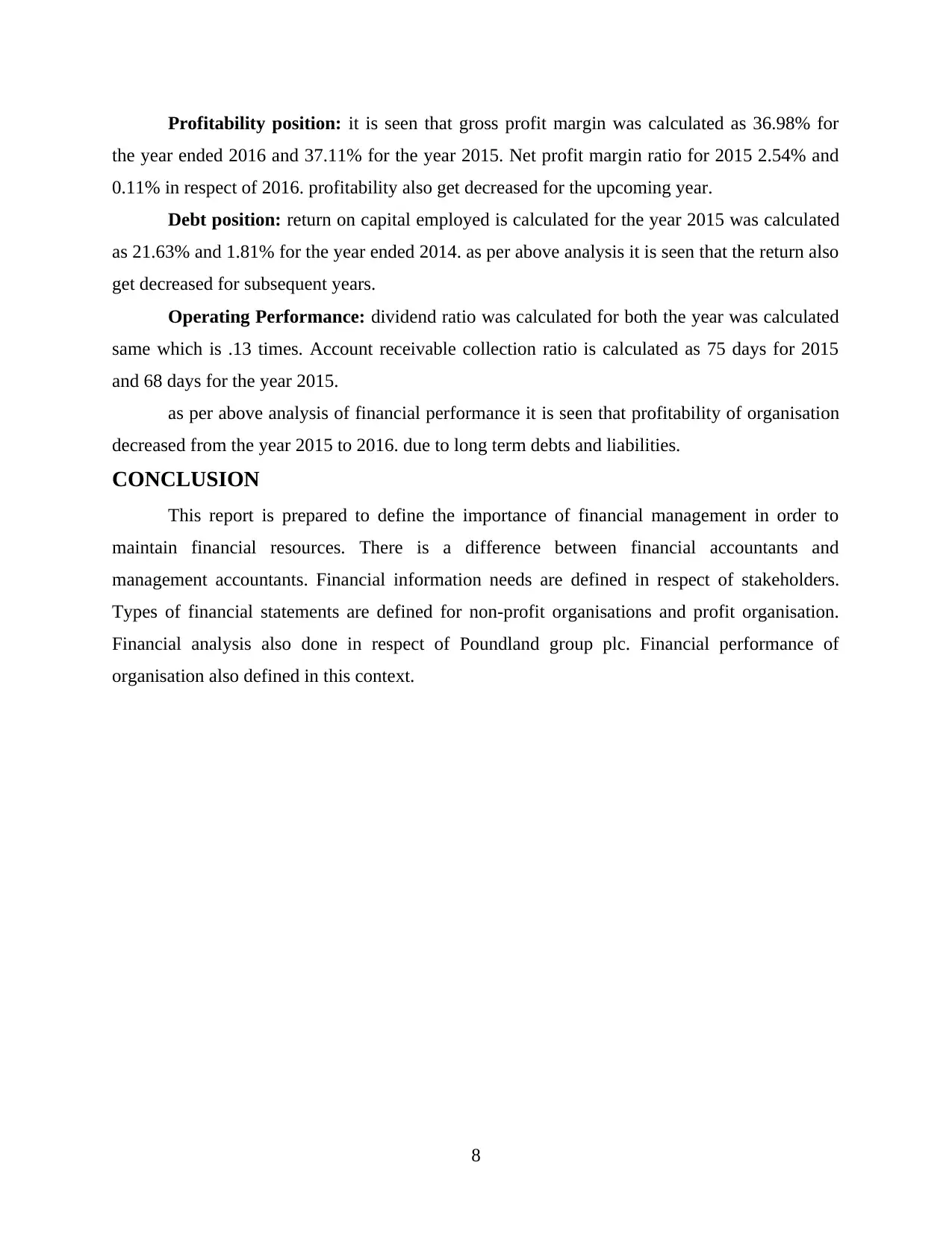
Profitability position: it is seen that gross profit margin was calculated as 36.98% for
the year ended 2016 and 37.11% for the year 2015. Net profit margin ratio for 2015 2.54% and
0.11% in respect of 2016. profitability also get decreased for the upcoming year.
Debt position: return on capital employed is calculated for the year 2015 was calculated
as 21.63% and 1.81% for the year ended 2014. as per above analysis it is seen that the return also
get decreased for subsequent years.
Operating Performance: dividend ratio was calculated for both the year was calculated
same which is .13 times. Account receivable collection ratio is calculated as 75 days for 2015
and 68 days for the year 2015.
as per above analysis of financial performance it is seen that profitability of organisation
decreased from the year 2015 to 2016. due to long term debts and liabilities.
CONCLUSION
This report is prepared to define the importance of financial management in order to
maintain financial resources. There is a difference between financial accountants and
management accountants. Financial information needs are defined in respect of stakeholders.
Types of financial statements are defined for non-profit organisations and profit organisation.
Financial analysis also done in respect of Poundland group plc. Financial performance of
organisation also defined in this context.
8
the year ended 2016 and 37.11% for the year 2015. Net profit margin ratio for 2015 2.54% and
0.11% in respect of 2016. profitability also get decreased for the upcoming year.
Debt position: return on capital employed is calculated for the year 2015 was calculated
as 21.63% and 1.81% for the year ended 2014. as per above analysis it is seen that the return also
get decreased for subsequent years.
Operating Performance: dividend ratio was calculated for both the year was calculated
same which is .13 times. Account receivable collection ratio is calculated as 75 days for 2015
and 68 days for the year 2015.
as per above analysis of financial performance it is seen that profitability of organisation
decreased from the year 2015 to 2016. due to long term debts and liabilities.
CONCLUSION
This report is prepared to define the importance of financial management in order to
maintain financial resources. There is a difference between financial accountants and
management accountants. Financial information needs are defined in respect of stakeholders.
Types of financial statements are defined for non-profit organisations and profit organisation.
Financial analysis also done in respect of Poundland group plc. Financial performance of
organisation also defined in this context.
8
Paraphrase This Document
Need a fresh take? Get an instant paraphrase of this document with our AI Paraphraser
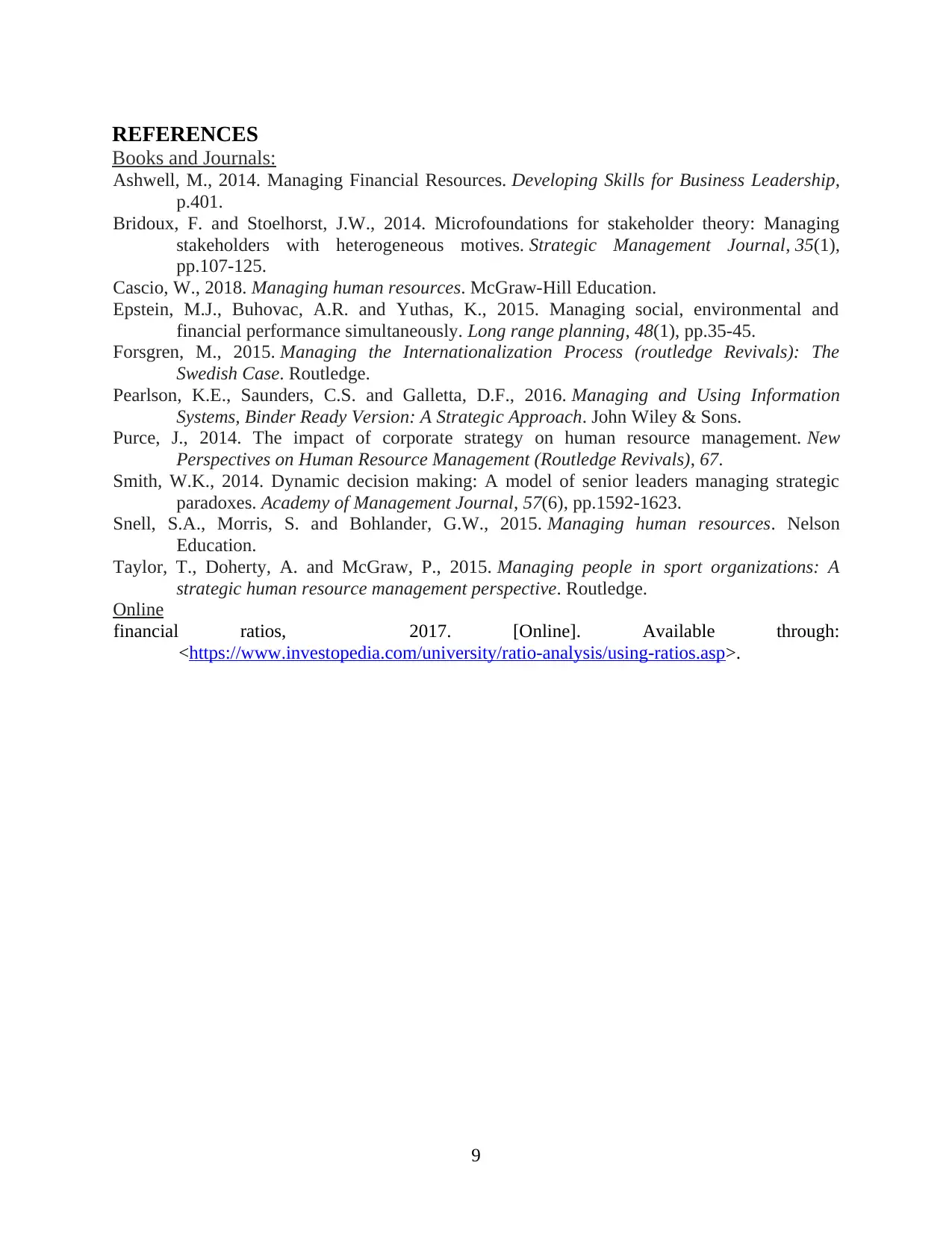
REFERENCES
Books and Journals:
Ashwell, M., 2014. Managing Financial Resources. Developing Skills for Business Leadership,
p.401.
Bridoux, F. and Stoelhorst, J.W., 2014. Microfoundations for stakeholder theory: Managing
stakeholders with heterogeneous motives. Strategic Management Journal, 35(1),
pp.107-125.
Cascio, W., 2018. Managing human resources. McGraw-Hill Education.
Epstein, M.J., Buhovac, A.R. and Yuthas, K., 2015. Managing social, environmental and
financial performance simultaneously. Long range planning, 48(1), pp.35-45.
Forsgren, M., 2015. Managing the Internationalization Process (routledge Revivals): The
Swedish Case. Routledge.
Pearlson, K.E., Saunders, C.S. and Galletta, D.F., 2016. Managing and Using Information
Systems, Binder Ready Version: A Strategic Approach. John Wiley & Sons.
Purce, J., 2014. The impact of corporate strategy on human resource management. New
Perspectives on Human Resource Management (Routledge Revivals), 67.
Smith, W.K., 2014. Dynamic decision making: A model of senior leaders managing strategic
paradoxes. Academy of Management Journal, 57(6), pp.1592-1623.
Snell, S.A., Morris, S. and Bohlander, G.W., 2015. Managing human resources. Nelson
Education.
Taylor, T., Doherty, A. and McGraw, P., 2015. Managing people in sport organizations: A
strategic human resource management perspective. Routledge.
Online
financial ratios, 2017. [Online]. Available through:
<https://www.investopedia.com/university/ratio-analysis/using-ratios.asp>.
9
Books and Journals:
Ashwell, M., 2014. Managing Financial Resources. Developing Skills for Business Leadership,
p.401.
Bridoux, F. and Stoelhorst, J.W., 2014. Microfoundations for stakeholder theory: Managing
stakeholders with heterogeneous motives. Strategic Management Journal, 35(1),
pp.107-125.
Cascio, W., 2018. Managing human resources. McGraw-Hill Education.
Epstein, M.J., Buhovac, A.R. and Yuthas, K., 2015. Managing social, environmental and
financial performance simultaneously. Long range planning, 48(1), pp.35-45.
Forsgren, M., 2015. Managing the Internationalization Process (routledge Revivals): The
Swedish Case. Routledge.
Pearlson, K.E., Saunders, C.S. and Galletta, D.F., 2016. Managing and Using Information
Systems, Binder Ready Version: A Strategic Approach. John Wiley & Sons.
Purce, J., 2014. The impact of corporate strategy on human resource management. New
Perspectives on Human Resource Management (Routledge Revivals), 67.
Smith, W.K., 2014. Dynamic decision making: A model of senior leaders managing strategic
paradoxes. Academy of Management Journal, 57(6), pp.1592-1623.
Snell, S.A., Morris, S. and Bohlander, G.W., 2015. Managing human resources. Nelson
Education.
Taylor, T., Doherty, A. and McGraw, P., 2015. Managing people in sport organizations: A
strategic human resource management perspective. Routledge.
Online
financial ratios, 2017. [Online]. Available through:
<https://www.investopedia.com/university/ratio-analysis/using-ratios.asp>.
9
1 out of 11
Related Documents
Your All-in-One AI-Powered Toolkit for Academic Success.
+13062052269
info@desklib.com
Available 24*7 on WhatsApp / Email
![[object Object]](/_next/static/media/star-bottom.7253800d.svg)
Unlock your academic potential
Copyright © 2020–2025 A2Z Services. All Rights Reserved. Developed and managed by ZUCOL.





